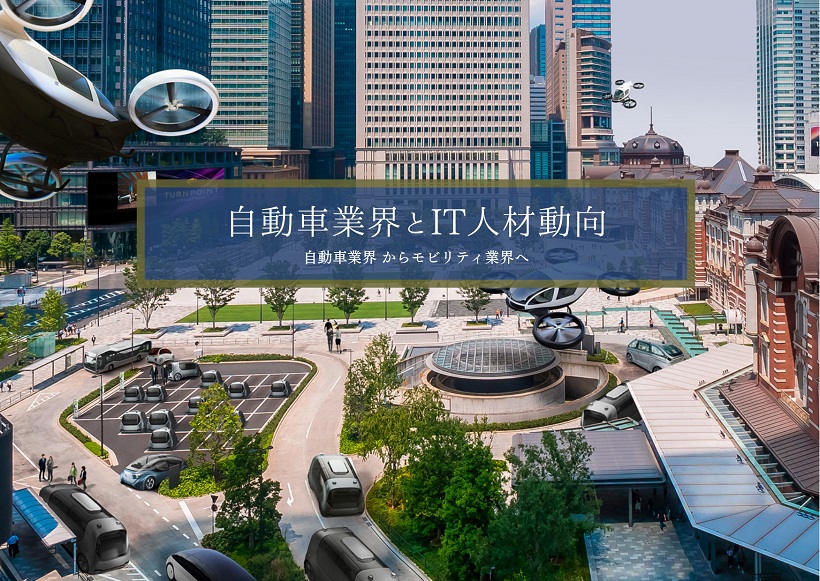- Top
- Turnpoint Media
- Mobility Industry Trends
- Automotive Industry x IT Human Resource Trends
モビリティ業界動向
Automotive Industry x IT Human Resource Trends

Need help with your job search?
Consultation
- I don't know if there is a job that fits my criteria
- I don't have time to look for jobs.
- I want to start thinking about career planning.
Turnpoint Consulting is a recruitment agency specializing in the automotive and mobility industry. Our industry experts will support you in your career.
Table of Contents
The automotive industry, one of Japan’s key industries, is currently undergoing a CASE revolution that is bringing about major changes in the industry. Based on data including the Japan Automobile Manufacturers Association (JAMA), this article describes the current state of the automotive industry from the perspective of employment and human resources, as well as the business transformation that automakers are facing and the resulting changes in the job market.
We will also focus on the status of IT personnel requirements and challenges, introduce IT personnel training initiatives at automobile manufacturers, and look at the extensive demand for digital personnel involved in the development of advanced technologies. We hope that you will find this seminar useful in understanding the current state of the Japanese market and in gathering information to advance your career.
Employment and workforce in automotive-related industries
In 2022, the automotive industry will account for 17.1% of all automotive-related manufactured goods shipments in Japan, and 19.1% for transportation equipment. The percentage of workers in the automotive industry, which supports this key industry, is 5.54 million out of a total employed population of 67.23 million, which means that approximately 8.2% of Japan’s employed population (in 2022) will be employed in the automotive industry.
Percentage of the population employed in the automotive industry

Reference: Based on Japan Automobile Industry 2023
Of the 5.54 million people, about 16% are employed in the manufacturing sector, such as manufacturers of finished vehicles and parts, and 18.2% in the maintenance and sales sector. The majority of the population is in the freight transportation and other use portion, which accounts for more than half of the total. Looking at the changes in the working population by sector over the past five years, the manufacturing sector has approximately 900,000 workers, the utilization sector has approximately 2.7 million workers, the related sectors have approximately 350,000-400,000 workers, the materials sector has 500,000 workers, and the sales and maintenance sector has approximately 1 million workers, with some annual changes but no major changes overall.
Automotive Industry Workforce – Breakdown

Population of IT Workers in Japan
The ratio of people working in IT occupations, which are said to be in the greatest need today, to the total workforce is said to be approximately 900,000|1.3%, showing how inadequate the IT workforce is despite the high need in the automotive industry. According to the “Results of a Survey on the Latest Trends and Future Estimates of IT Human Resources” published by the Ministry of Economy, Trade and Industry, there will be a shortage of approximately 790,000 IT workers by 2030.
Business turnaround of various companies in the automotive industry and increase in IT-related jobs
In recent years, the automotive industry has been undergoing a business transition in line with the advancement of advanced technologies. In particular, as automated driving technology and connected services become more commonplace, accompanied by the rise of new EV manufacturers and changes in the goals of complete vehicle manufacturers, there has been a shift from a traditional hardware-centric business model to a more technology-focused business.
The impact of these technological changes is not limited to Japan, but is affecting employment in the automotive industry worldwide.
In Germany, for example, the automotive industry is undergoing a major transformation and is experiencing a significant decline in employment. Due to the shortage of semiconductors, structural changes in the automotive industry, and the impact of the new coronavirus, the German automotive industry has lost approximately 67,000 jobs, or 7% of its 838,000 jobs. This job loss is likely to continue, and Hoffmann, president of the German trade union IG Metall, noted that future strategies are key to continuing to create value in Germany for both automakers and parts suppliers.
Estimates exist that 410,000 jobs will be lost by 2030 if no action is taken. On the other hand, the report also shows that a gap between supply and demand is emerging, as new mobility and the desire for renewable energy are creating new jobs.
(See: Reuters)
A Case Study of CASE Adaptation and Business Transformation at a Foreign Auto Parts Manufacturer
Automotive companies are seeking new visions and strategies during this transformational period.
Bosch| Bosch
Bosch provides solutions for EV charging infrastructure and develops components for electric and fuel cell vehicles. In addition, various initiatives are underway for PACE (Personalized, Automated, Connected, and Electrified), including a software platform that seamlessly links the vehicle and the cloud in collaboration with Microsoft Corporation.
(External website: Bosch )
Continental| Contin ental
Continental of Germany is focused on above-average growth in the areas of connected, assisted, and autonomous driving; new vehicle architectures with software and high-performance computers; tire and contitech business in high-growth regions; and fleet and industrial customers. The company focuses on above-average growth in the areas of digital solutions and services, such as connected, assisted and autonomous driving, new vehicle architectures with software and high-performance computers, tires and ContiTech business in high-growth regions, fleet and industrial customers.
(External website: Continental )
Forvia| Forvia (Hella & Faurecia)
HELLA operates in three business areas: electronics, lighting, and lifecycle solutions. The merger with Faurecia, which operates in automotive seating, interiors, and electronics, will provide electronic The merger with Faurecia, which operates in automotive seating, interiors, and electronics, will cover the entire cockpit in response to the shift to electronic devices and EVs.
(External website: Forvia )
Plastic Omnium & AVL| Plastic Omnium & AVL
Plastic Omnium, a leading French automotive supplier of fuel systems and fuel tanks, has partnered with ElringKlinger on fuel cell technology to advance its global hydrogen strategy and with AVL on strategic hydrogen partnership.
(External site: Plastic Omnium)
Garrett Motion| Garrett Motion
Garrett Motion, a Swiss-based automotive parts manufacturer, is also focusing on cyber security solutions for connected cars from its core areas such as turbochargers and compressors.
(External website: Garrett Motion )
Webasto| Webasto
Webasto, a German company that handles roof systems and cooling solutions, also focuses on the development and manufacture of charging stations and other products for electric vehicles.
(External site : Webasto )
Magna & LG electronics| Magna & LG electronics
Canadian auto parts giant Magna International and LG Korea have established the LG Magna e-Powertrain joint venture to focus on electric powertrains for electrification.
(External site : Magna International )
ZF
Germany’s ZF, a leader in drive train, chassis technology and safety, is undergoing a transformation that includes the establishment of an electric powertrain technology division, integration with WABCO, a technology provider for commercial vehicles, sales of software solutions, and the launch of a new software center.
(External website: ZF )
As this situation clearly shows, the transformation of the automotive industry has also affected the job market, with a sharp increase in demand for specialists, especially in new technical areas. Companies are responding by developing strategies to increase their own competitiveness, with an emphasis on aggressive hiring and improving the skills of their employees.
Increase in IT jobs
In terms of the job situation, the automotive industry has seen a rapid increase in software-related jobs. This is due to the fact that the impact of software on functionality and performance is significantly expanding as vehicles become more and more SDV (Software Defined Vehicle). In particular, with the introduction of 5G, there is an increase in jobs in the connected domain, where updates can be based on wireless communications such as automated driving technology, vehicle network connectivity, and OTA (Over-the-Air). This trend has spilled over into the in-vehicle systems and cybersecurity domains, with the number of job openings growing rapidly compared to a few years ago.
[Areas where software jobs are increasing]
・Automated driving area
・Connected area
・Cyber security area
・MaaS area
In terms of job types, a wide range of positions are being filled, including data analysis and mobile app-related jobs in the MaaS domain, while positions requiring system development and operations skills, such as SE and infrastructure engineers, are attracting talent from outside the automotive industry. On the other hand, jobs for embedded engineers generally require experience in the automotive industry.
Application engineer and test engineer jobs are often found at foreign manufacturers to embody the developed technologies in the Japanese market. Another area where hiring needs are increasing due to legal regulations, but where human resources are depleted is in the cyber security area. In particular, there is a limited number of engineers in the cyber security domain in the Japanese market, highlighting the issue that it is difficult to find highly skilled personnel in Japan who are required by overseas headquarters.
In addition to technical positions, sales and other administrative positions also require knowledge of their respective technologies, and acquisition of IT knowledge is now required regardless of job type.
Challenges and Issues of the IT Workforce Shortage
Japan faces a variety of challenges in securing IT personnel.
One factor is the ” declining birthrate and aging population” and“IT education,” which is lacking compared to other countries. Another factor is “hard work and low salaries. Many Japanese IT professionals work for IT companies such as system integrators (Sier), and development is generally outsourced to subcontractors in the field of system development. Due to this outsourcing structure, engineers at subcontractors are often forced to work on development tasks under tight schedules and work overtime. Salaries are also lower than those of engineers at foreign companies, and while the number of job openings is increasing, there are many situations in which applicants do not apply for these positions because of the salary.
According to a survey by a major human resources firm, 65% of digital professionals earn between 3.9 and 5.4 million yen per year, with 5% earning over 6.15 million yen and a handful earning 10 million yen. The survey also found that in 17 other countries, salaries for IT professionals are higher than in Japan.
The shortage of IT personnel is an issue facing all industries in Japan, regardless of industry. According to the Global Competitiveness Ranking by the International Institute for Management Development (IMD) of Switzerland, Japan’s IT (digital technology) ranked 28th out of 63 countries in 2021. (Reference: IMD Digital Competitiveness Ranking)
Simultaneous hiring and training required
Digital Divide between Large and Small Businesses
To cope with this situation, companies need to secure and train IT personnel at the same time. There is a shortage of IT personnel in major companies, and many companies are already implementing large-scale IT personnel training programs. On the other hand, SMEs, which employ 70% of Japan’s workforce, are struggling to acquire IT personnel, and according to the 2020 White Paper on IT Human Resources, a higher percentage of companies with 1,000 or fewer employees feel that they have a “significant shortage of IT personnel” than companies with more than 1,001 employees. A “digital divide” has emerged between large companies and small and medium-sized companies.
Raise awareness of individual IT skills
On the other hand, the new coronavirus has led to widespread telecommuting, and individuals are increasingly aware of the need to improve their IT skills. The number of examinees for the IT Passport examination administered by the Information-technology Promotion Agency, Japan, has been increasing every year, more than tripling compared to five years ago. In response to this growing awareness, companies need to actively focus on recruiting from outside the company by helping employees improve their IT skills through such measures as establishing a support system for certification acquisition, and by creating an environment where IT personnel want to work.
Recruitment of talented overseas personnel
– Promoting Diversity and Inclusion
Another solution is to hire excellent overseas personnel. Although there is a language barrier, there are many excellent IT personnel from overseas who have studied information processing skills as a required subject, and an increasing number of companies are actually hiring foreign IT personnel. In addition, by aiming for a system that easily accepts foreign nationals, corporate diversity and inclusion will also be promoted.
– Government Promotion of Acceptance of Highly Skilled Human Resources
In order to promote the acceptance of excellent foreign IT personnel, the Japanese government has established a “highly skilled personnel point system” and is preparing to accept highly skilled personnel who have reached a certain point total by offering them preferential treatment in terms of immigration and residency management. (Reference: JETRO’s preferential treatment system for highly skilled foreign personnel based on the point system )
– Annual salary of foreign engineers
However, it is important to recognize that while the recruitment of excellent foreign engineers will fill in areas that could not be secured with domestic personnel and promote innovation, the annual salary rate for such foreign engineers will be higher. In the field of recruiting, there are many cases in which the amount offered is low and excellent candidates cannot be obtained because “it is not possible to raise salaries only for personnel in the IT department. First of all, it is necessary to review the salary structure and build a foundation for acquiring excellent IT personnel.

In-House Training of IT Personnel at an Automobile Manufacturer
Major automakers are also actively promoting in-house training of software personnel. Here are some examples of efforts by complete vehicle manufacturers and parts suppliers.
Honda| Honda
Honda will strengthen cooperation with KPIT Technologies, a software development company in India, in March 2023 and will collaborate with SCSK in July 2023, aiming to increase the number of personnel responsible for development by 1,100 by 2030. While the collaboration with KPIT Technologies is aimed at strengthening competitiveness in software development overseas, the collaboration with SCSK seems to be aimed at competition in Japan.
(Reference: Honda collaborates with SCSK on software development to strengthen SDV competitiveness )
Nissan|Nissan
The Software Training Center (STC) was established in 2017 and trains 100 people per year. Over a period of about 3.5 months, students learn the basics of software. They learn tools used for model-based development, which has become mainstream in software development, development standards, and the concept of development, aiming to develop human resources who are well versed in software development, including automated driving at Nissan.
(Reference: “Training World-Class Software Engineers,” Nissan Unveils Training Facility for the First Time )
Toyota
Toyota aims to encourage 9,000 people to reskill by 2025 and turn them into software professionals by taking courses and learning programming languages, etc. In collaboration with Woven Planet, Toyota Connected, and overseas development bases, Toyota aims to build a global software development structure of 18,000 people and promote software development around the world. We aim to promote software development worldwide by building a software development system with 18,000 employees globally in cooperation with Woven Planet, Toyota Connected, and overseas development bases.
(Reference: Why does Toyota insist on “in-house” software development?)
Volkswagen| Volkswagen
Volkswagen plans to establish “CARIAD” in 2019 to take charge of its software business and accelerate its development with more than 5,000 experts by 2025. This initiative is aimed at sharing software platforms in all new models within the group and raising the in-house software development rate from less than 10% to more than 60%. In addition, in order to develop internal IT personnel, we are training them to become junior software developers based on the “Faculty 73 Program”.
(Reference: Volkswagen looking for IT talents for third generation of faculty 73 )
Bosch|Bosch
We are investing about 280 billion yen over 10 years until 2026 to reskill our workforce of about 400,000 workers. Bosch has established “Bosch Training Centers” in seven locations around the world to provide training and learning tools and to promote a learning culture throughout the company. Japan is also part of our global network, and in cooperation with our overseas offices, we are in charge of planning and organizing training programs for Bosch Japan employees.
(Reference: “Reinforcing reskilling for software engineer training” )
Denso|Denso
is working on “CIP: Career Innovation Program,” a career development support program for software engineers. Through the CIP, we are working to convert 1,000 parts engineers into software engineers by 2025.
We have also established an overnight global training facility called “AQUAWINGS” and are working to build an environment that supports employee growth.

summary
The automotive industry has expanded beyond its former framework of manufacturing, not only producing and selling vehicles, but also expanding with peripheral technologies and new services, developing into a broad mobility industry. This change has brought about a shift to a new era that requires seamless collaboration with other industries.
In mobility services and automated driving, which are central to the development of new technologies, there is a notable shortage of IT human resources in Japan. In light of this situation, we have found it necessary to further strengthen the training of digital human resources while attracting excellent human resources from Japan and abroad.
The shortage of IT personnel is not limited to the automotive industry, but is common to all industries. In order to promote the mobility industry and build careers, each individual, regardless of industry or job title, needs to focus on information gathering, online training, and self-development to grow as a digital workforce. IT literacy needs to be improved not only in engineers, but also in administrative positions.
Adapting to changing times and increasing the number of tech-savvy IT professionals will be critical to future success in the Japanese market and will be key to increasing market value.
Turnpoint Consulting, Inc. provides job search support with a particular focus on the automotive and mobility industry, and can assist you in many ways, such as practicing for interviews and correcting your answers. If you have any questions or concerns about your job search or career change, please feel free to let us know.
Supervision: Turnpoint Consulting Media Team (Supervision: Shintaro Kondo)
We are a media team that provides useful information about changing jobs related to the automotive and mobility industry. For those who are thinking about changing jobs, we will provide information about the job market in the automotive and mobility industry and how to prepare for the selection process, and for corporate recruiters, we will provide information about the flow of human resources in this industry. Our goal is to help you by providing information about changing jobs and recruitment in the automotive and mobility industry.
Need help with your job search?
Consultation
- I don't know if there is a job that fits my criteria
- I don't have time to look for jobs.
- I want to start thinking about career planning.
Turnpoint Consulting is a recruitment agency specializing in the automotive and mobility industry. Our industry experts will support you in your career.
Supervisor of this article
Turnpoint Consulting Co.
Turnpoint Media Management Office
Turnpoint Consulting is a specialist recruitment agency for the automotive and mobility industry. Turnpoint Media will provide you with useful information on industry trends and career opportunities.
Related Articles
-
2025.06.21
Job Change x Trend News] Can’t Take My Eyes Off of You! Summary of the latest EV situation
-
2025.06.21
Gigacast is the key to EV manufacturing! Summary of companies introducing Gigacast
-
2025.06.20
Job Change x Trend News] By Manufacturer! Summary of the latest situation of self-driving cabs
Search by Industry
Consultation
Our expert team is dedicated to empowering your career change, crafting tailored career plans, and securing the best job opportunities in the automotive and mobility sectors.
- Top
- Turnpoint Media
- Mobility Industry Trends
- Automotive Industry x IT Human Resource Trends















